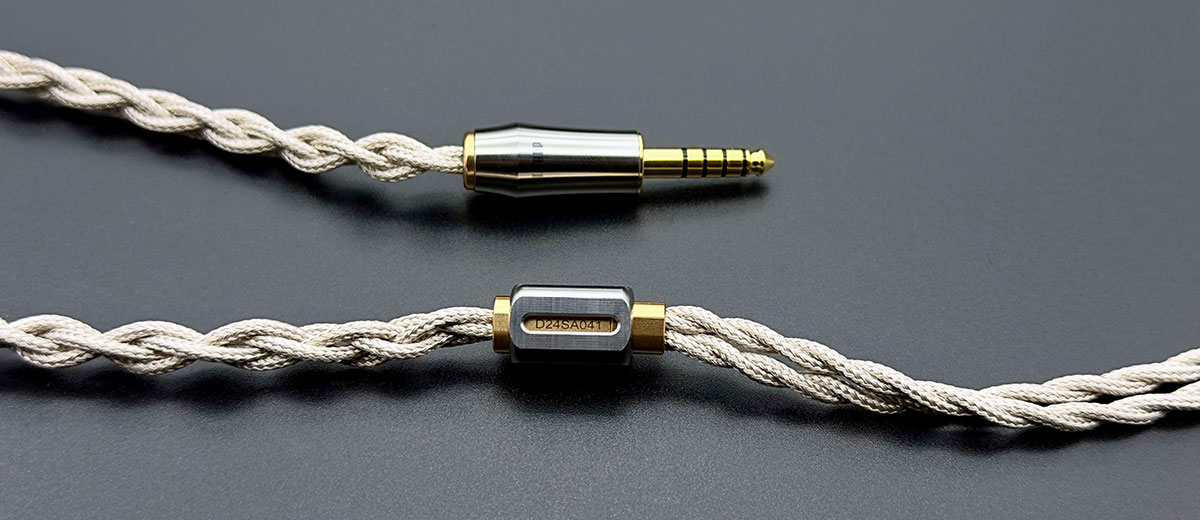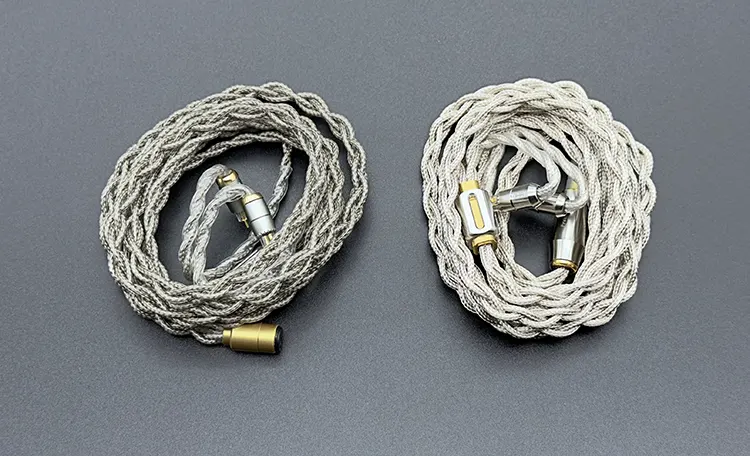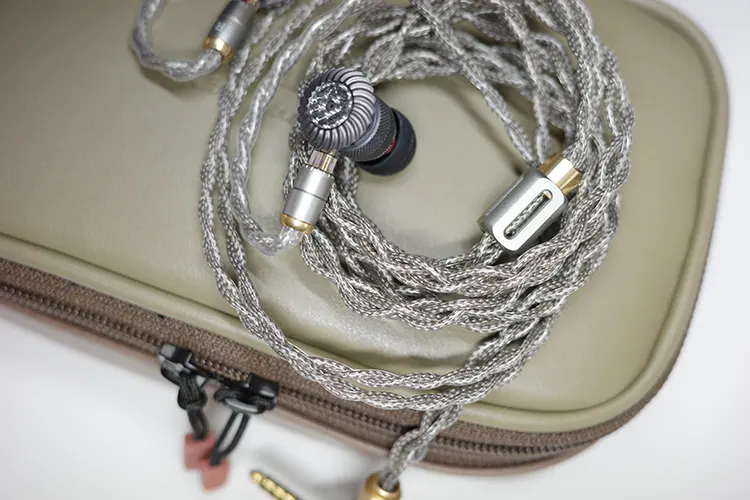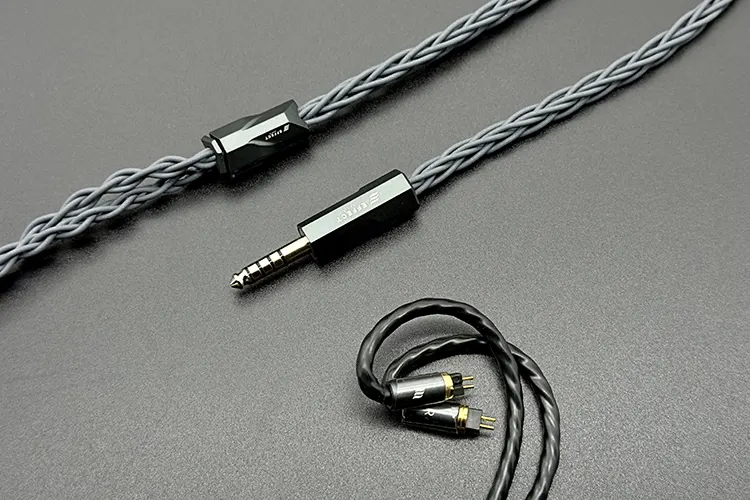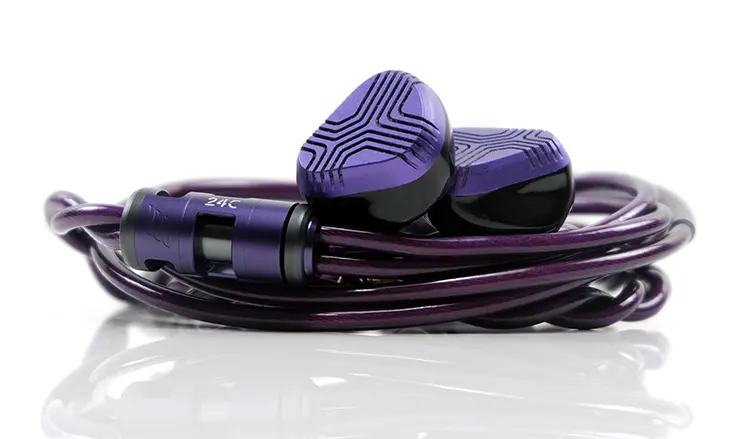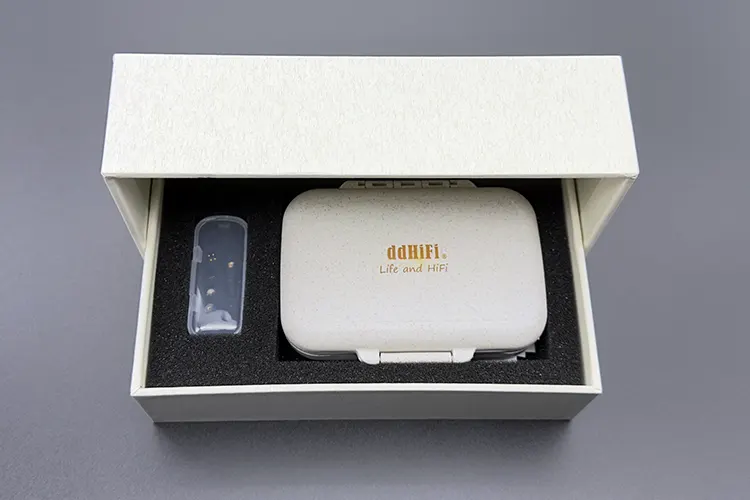Select Comparisons
ddHiFi Nyx Pro
Technical
The Nyx Pro is a 4-wire cable featuring a predominantly single monocrystalline copper wire, along with an additional pure silver core of slightly larger diameter.
The overall ratio is 1:3 silver to copper, with 7 strands of silver and 56 strands of copper in a Type 2 Litz configuration. The silver cable has a diameter of 0.08mm, while the copper strands measure 0.05mm in diameter.
The wire gauge chosen is the same 25.4 AWG as the Nyx Net. The Nyx Pro wire’s shielding employs a silver-coated conductive fiber material, which is woven between the inner and outer insulation layers.
Design
The Nyx Pro is more sophisticated and robustly built. The outer jacket of the cable is made of transparent PVC, which gives it some firmness. The fiber mesh layer on the Nyx Net makes it thicker, but it is less firm and easier to roll. The Nyx Pro cable is lighter of the two.
Both cables share similarities in hardware, featuring a similar but sharper Y-split and interchangeable pin system.
Where the Nyx Pro excels is in its presentation, accessories, and modularity, which make it versatile. The termination adapter on the Nyx Pro is built more robustly. The interchangeable pin system is the same on both cables.
Performance
I tried both cables on multiple IEMs. Both these cables bring out the true character of the IEMs with some subtle differences. The Nyx Pro cable excels at bringing out the details more vividly and sounds more expansive of the two.
In the bass region, the Nyx Pro has more tightness and punch. The texture and layering are also better with this cable. The bass is more detailed and refined with the Nyx Pro.
The Nyx Net cable, however, does not alter the impact level much but feels a bit loose overall. The mid-bass loses its tightness and control.
In the midrange, both cables add some warmth. The Nyx Pro brings out more detail and clarity in the midrange, giving vocals and midrange instruments more space to breathe.
The difference in refinement that the Nyx Pro brings over the Nyx Net is quite noticeable. The midrange has better resolution and a fuller presence with the Nyx Pro.
In the upper midrange to the treble region, the Nyx Net adds more energy, whereas the Nyx Pro remains smooth while keeping the treble region refined.
The extra energy with the Nyx Net adds a hint of sharpness, which is nicely controlled on the Nyx Pro. For some neutral to bright IEMs, the Nyx Net should be paired with caution.
The soundstage is more expansive with the Nyx Pro, where I notice an improvement in width compared to the Nyx Net. Both cables provide nice depth to the stage. While I appreciate both cables for what they offer, the Nyx Pro is a clear upgrade over the Nyx Net cable.
Effect Audio Eros S II
Technical
The Eros S II cable features an 8-wire, 26AWG configuration made from ultra-pure OCC silver and copper Litz wires, making it the sole hybrid model in the Signature Series II.
It employs a proprietary Tri-Element synCompound design, combining a central pure silver core with six multi-sized core bundles of a silver-copper alloy and pure copper.
Design
The cables differ significantly in design and aesthetics. The Eros S II sports a dark gray matte sleeve accented with subtle silver sparkles, giving it a refined, understated appearance. Despite its thickness, the cable remains flexible due to a less densely braided design.
The Y-split features forged carbon fiber with unique accents that match the cable’s color scheme. Both the termination adapters and pin connectors are well-built and durable.
Similar to the Nyx Net interchangeable pin system, the Eros S II is equipped with Effect Audio’s ConX technology, allowing easy connector swaps for compatibility with various IEMs, including 2-pin, MMCX, and Pentaconn Ear.
However, interchangeable pins must be purchased separately for the Eros S II.
Performance
The Eros S II combines the strengths of copper and silver, delivering a balanced sound profile with a focus on clarity and resolution. In contrast, the Nyx Net emphasizes impactful bass and an enhanced treble response.
The Eros S II offers tighter, more textured bass, while the Nyx Net delivers better impact and punch but lacks the same tightness and control. The Nyx Net also provides a denser lower midrange with better presence, adding richness to vocals and instruments.
In comparison, the Eros S II offers a more neutral midrange with clearer, sharper resolution, whereas the Nyx Net leans toward a more musical presentation.
In the upper midrange to treble, the cables diverge significantly. The Nyx Net has a sharper, weightier presentation in this region, while the Eros S II feels thinner in comparison but still offers good extension.
Notes in this range are taller and carry more weight on the Nyx Net, which also features an airier profile with enhanced sparkle.
Regarding soundstage, the Nyx Net provides greater depth, creating a more holographic experience. Both cables share a similar stage width. The Eros S II excels in imaging with pinpoint accuracy, offering a more precise and detailed presentation.
Effect Audio Code 24C
Technical
The Code 24C is a limited-edition cable featuring Effect Audio’s Trio-Flex Pure Solid Core System, which incorporates 17 multi-sized core bundles. It utilizes a two-wire configuration and is crafted with high-purity UP-OCC Copper Litz wire cores.
Designed with 18.5AWG wires, the cable also features Effect Audio’s signature Ultra-Flexi outer insulation for added flexibility and durability.
Design
The Code 24C boasts a vibrant color scheme and more elegant hardware compared to the toned-down color scheme of Nyx Net. It has a thick, slightly reflective purple jacket. The cable is stiffer compared to the flexible nature of the Nyx Net.
The Y-split and termination adapter are larger and feel sturdier than those on the Nyx Net. Due to the stiffness of the Code 24C, it requires more space to store. I find the Nyx Net more comfortable to use due to its easy handling.
Performance
Like the Nyx Pro, the Code 24C stands out for its relaxed yet highly refined sound. While Code 24C is not as energetic sounding, its level of clarity is a clear differentiator. Pairing it adds some extra warmth to the sound.
In the bass region, the Code 24C does a better job of bringing out the details and providing a nicely textured low end. The mid-bass is more controlled and tighter than what I find on the Nyx Net.
Though the impact level is nearly the same, it’s the quality of Code 24C’s bass that stands out. It feels more precise and reaches deeper.
The midrange is where the Nyx Net falters a bit. You don’t get a very refined and clean response in the midrange, which the Code 24C handles with ease.
The Code 24C delivers a richer, more musical midrange. The vocals are more detailed, and the nuances are better conveyed on the Code 24C. The coherence from the midrange to the upper midrange and treble region is better achieved on the Code 24C.
The upper midrange on the Nyx Net is more energetic and can come across as quite sharp on occasion, as mentioned earlier. Code 24C has a smoother presentation while maintaining great detail. To me, the treble presentation on the Nyx Net feels a bit exaggerated at times.
The Code 24C offers a more expansive soundstage with better depth. The presentation feels more holographic, and the instruments are better spaced out. The Nyx Net restricts the width of the soundstage. The resolution and detailing are also better on the Code 24C.
My Verdict
ddHiFi has consistently focused on creating premium products that not only feel luxurious but also stand out with their impressive quality.
This is my first time trying ddHiFi cables, and I’ve loved the experience. The Nyx Net IEM cable, with its beautiful design, robust build, and solid performance, holds its place confidently in the brand’s lineup.
While I enjoyed the experience, there is certainly room for improvement to make it even better. I missed the refinement of the Nyx Pro. The Pentaconn termination plug is a nice touch, but the addition of modularity to switch between 4.4mm and 3.5mm ends would enhance its versatility.
The cable tends to push bright IEMs into a spicier territory, which can sometimes feel exaggerated. However, this characteristic can also improve the treble profile on certain IEMs.
Beyond these points, I have no complaints. The cable deserves full marks for its build quality and handling.
ddHiFi Nyx Net Specifications
- Material: High-Purity OCC (Taiwan) – Litz Type 2
- Cable Structure: (0.08mm×1+0.05mm×8) ×7×4 wires (Pure OCC)
- Plug: 4.4mm Balance (also available in Pentaconn OFC 4.4mm)
- Connector: 78 mm 2-pin × 2, MMCX × 1
- Weight: About 40g
- Length: 1.2m

